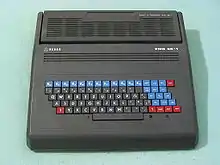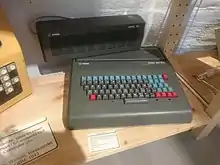PMD 85
The PMD 85 was an 8-bit personal computer produced from 1985 by the companies Tesla Piešťany and Tesla Bratislava in the former Czechoslovakia.
 PMD 85-1 | |
| Manufacturer | Tesla Piešťany |
|---|---|
| Introduced | 1985 |
| Processor | MHB8080A |
| Frequency | 2.048 MHz |
| Memory | 48 KiB RWM, 4 KiB ROM |
They were deployed en masse in schools throughout Slovakia, while the IQ 151 performed a similar role in Czech part of the country. On the PMD 85 were created the first Czechoslovak video games, other platforms were ZX Spectrum and Atari.
This computer was produced locally due to a lack of foreign currency with which to buy systems from the West. After the Velvet Revolution in 1989, production of the PMD 85 was stopped. PMD 85 was not competitive in quality or features compared to foreign PCs available at that time.
Specifications
- MHB8080A 2.048MHz CPU (clone of Intel 8080)
- 48 KiB RAM (PMD 85-2A and 3, 64 KiB)
- 4 KiB ROM (PMD 85-3, 8 KiB)
- System monitor
- Tape utilities
- TV output (B/W, PMD 85-3 PAL) or RGB component video
- 288×256 resolution
- 4-level attribute (flickering, grayscale or colours, depending on model), selectable per 6-pixel-wide stripes
- Tape recorder interface
- IRPS interface (passive current loop RS-232 without modem control signals)
- Module interface. A ROM module with the BASIC programming language was a standard part of the computer, but there were more ROM modules containing Pascal, Assembler, LOGO etc. A programmer was also available.
- IMS-2 interface (non-standard connector and electrically partially non-conforming) based on MHB8255A
- Two 8-bit parallel buses supporting handshaking (via second MHB8255A)
- Application connector (de facto system I/O bus)
Variants

- The PMD 85-0, a prototype produced by Tesla Piešťany (author was Roman Kišš), was originally in a white-coloured case and later in some other colours. It is quite rare today.
- The PMD 85, produced by Tesla Piešťany since 1985, was known as the PMD 85 or PMD 85-1. It was made with a dark gray case, and was known for its keyboards with extremely tough keys. Alphanumeric keys were evaluated at the moment of a key release.
- The PMD 85-2, produced by Tesla Piešťany since 1986, introduced some improvements in BASIC, some in input routines (for instance, key autorepeat), a more ergonomic keyboard (but less mechanically reliable) and also terminal mode. Some of the changes caused it to be not completely backward compatible.
- The PMD 85-2A, produced by Tesla Bratislava since 1987, used 64 Kib RAM chips instead of 48 Kib, leading to less overheating of the memory chips, resulting in more memory available for BASIC, but was otherwise compatible with PMD 85-2.
- The PMD 85-3, produced by Tesla Bratislava since 1988, added colour TV output. Character encoding included all Czech and Slovak characters, and a Cyrillic version was also produced. System memory was enlarged to 8 KiB and monitor included routines for communication with PMD 32 floppy disk assembly, a ROM integrity test and also "PMD 85-2 compatibility mode" by relocation.
The PMD 85-2 was an inspiration for the MAŤO personal computer, also sold as a self-assembly kit. It had different hardware and very limited compatibility with PMD; its BASIC, memory structure and I/O were almost, but not completely the same, but tape format was different. It was intended as a home computer, but never really caught on.
Later, the Didaktik Alfa and Beta were produced as more reliable clones.